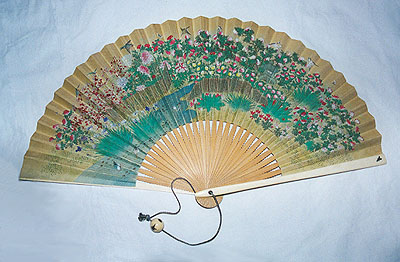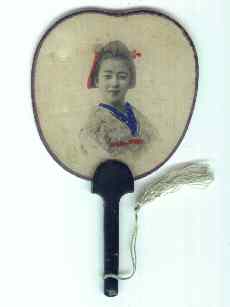Fans have a long history in Japan, and according to legend, Japan is the homeland of the modern folding fan. The earliest evidence of the fan in Japan was discovered in the wall paintings of a burial mound dating from the 6th century AD in Fukuoka. These depicted the Chinese style ceremonial fan.

Chinese influence was strong in Japan during this period and these fans were obviously modelled on the fans of the Han dynasty in China. Early Japanese fans were of two types, the tuan shan ’round fan’ and the bian mian ‘screen fan’. The latter was any rigid fan which could be conveniently held in the hand. It was traditionally made of feathers or silk stretched over a round or oval frame. The Ceremonial fan differed essentially in that it was of a larger size, and was mounted on a long pole and used by attendants in the ceremonial entourage of high officials at important functions or processions.
There are three basic types of folding fan, the feather, the folding fan and the brisé, constructed from rigid segments held together at the base by a rivet and joined at the top by a thread or ribbon. According to both Chinese and Japanese legend the brisé was invented by a court official who threaded together the thin wooden or ivory staves that all officials carried for the purpose of writing, thus creating the first form of crude brisé, called in Japanese Mokkan. The folding fan with a separate leaf is the source of another Japanese legend, in which Toyomaru of Tamba province, made the first folding fan after being inspired by the sight of a bat’s wing during the time of the legendary Empress Jingu. Another story credits the accidental invention of the folding fan to the widow of Taira Atsumori who retired to the Mieido, a Kyoto temple. There she cured the abbot of a fever by uttering incantations and fanning him with a piece of paper folded into pleats.
The earliest literary references to the folding fan, in both Japan and China, date from the 10th century. A Japanese dictionary compiled around 935, for example, lists two types of fan, the Uchiwa and the Ogi, the generic term for a folding fan. There are also records dating from the Chinese Song dynasty recording gifts of folding fans at the Chinese court. By the end of the 10th century, the popularity of folding fans was such that sumptuary laws were enacted during the Choho era (999 -1003). While folding fans were widely used in Japan from the 12th century onwards, it was not until the 15th century that the same was true in China.
In Japan the fan quickly found a place in court, official and everyday life. The Japanese court fan was is the Hiogi. In its fully developed form it was a fan used for ceremonial purposes rather than for cooling oneself and it remained an item of court paraphernalia right through the 19th century. Originally, only the emperor was permitted to use the Hiogi though, in time, it was used by all levels of the court aristocracy.
The Hiogi consists of a large number of wooden blades, usually between 34 and 38, held together with a metal rivet in the form of a butterfly on the front of the fan and a bird on the back. That of the empress, however, required a rivet made of paper string. At the other end, the blades were connected together by means of a silk cord. The fan face was painted with bright colours with carefully prescribed designs of pines, chrysanthemums, plum or cherry blossoms and sometimes, birds on a white ground surrounded by stylised clouds in gold and silver, variously outlined in red, blue, green and purple. From the top of each guard stick hung clusters of artificial flowers and long silk cords of different colours. For those under 16 years of age, a similar Hiogi was used but was made of Cedar instead of Cypress wood.

The Gunsen (war fan) was a folding fan used by Generals, samurai and court officials, not has popularly supposed, as a weapon but to as a means of signalling during battle. The sticks were of black lacquer, with guards of bronze or iron which supported a heavy paper leaf upon which was displayed a sun or moon device. A description survives of Hacheman-taro’s Gunsen: ” In front with a mica fold sun device, the reverse with mica and a silver moon device ….. 12 bamboo sticks lacquered black and heavy with a metal oya-bone (guard).” The Gampi Uchiwa was a rigid shaped fan of military origin still used at Sumo wrestling. The Rikiu Ogi, or tea ceremony fan was said to have been invented by Sen-no-Rikiu the celebrated tea master in about 1550, who introduced it for passing little cakes during the tea ceremony and not for actual fanning.
There was also the Chukei or Noh theatre fan, made of simple bamboo sticks and guards with painted paper leaves. This fan went through various changes over the centuries. Noh, the classical theatre of Japan, combines drama, song and dance. The whole performance is supported by the use of symbolic props, of which the fan is the most important, Since much of the spoken word in this type of theatre is unintelligible to the average Japanese, the fan is used by the actor to accentuate almost every gesture throughout the drama and to indicate to the audience, through manipulation and symbolic meaning, what is taking place. The fan is used in a similar manner during performances of Kabuki, the popular theatre of Japan, which also combines acting and dancing.
From the court through the other strata of society the fan was always used as a New Year and marriage gift or for the coming of age of a 16 year old boy on his crowing day.

The evolution of the fan in Japan continued, but it was not until the Edo period (1690-1868) that any significant changes took place. Nor, indeed, until Japan opened her ports to Western trade in the early days of the Meiji Period (1868-1912) did the fan ascend to the heights of craftsmanship comparable to the fans of the China Trade period which was roughly contemporary with the Edo Period. There is no doubt that before this incentive of Western trade fan-making remained a cottage industry producing rather austere disposable fans for the home market as had been the case in China. The uses for the fan in Japan outnumber those of China, for the fan became the symbol of life itself to the Japanese, the sticks radiating out from the rivet symbolised the sun’s rays radiating out and supporting life itself in the form of the leaf.
The Edo period, which lasted for 250 years was not only a period of peace, but one of self-imposed isolation. By 1641, Japanese ships were forbidden to go abroad, while all foreigners were excluded from Japan, with the exception of the Dutch and Chinese traders who were confined to the port of Nagasaki. The policy was rigidly enforced so that Japan was effectively closed to outside influences during the Edo period until the arrival of Commodore Matthew C. Perry’s warships off Uraga Bay near Edo in 1853. Foreigners and outside influences slowly began to penetrate into Japan and, with the end of the Edo period and the Imperial restoration of 1868, the floodgates were well and truly open. Japan’s sudden opening to the outside world created an enormous demand for anything connected with Japan and a Japan craze seized Europe and the USA. It is against this background that Japan began to manufacture fans specifically for the export market.

As a result of the political and economic changes Japanese craftsmen began tailoring their skills and goods for sale abroad with what he thought the western market wanted. The result was objects of art which Westerners considered to be wholly Japanese, but which could barely have been recognised as such by the Japanese themselves. At the height of their popularity Japanese fans were exported in vast quantities. During the Japan craze the fan was one of the cheapest Japanese objects available in the West and, for the average person, was possibly the only Japanese item they could hope to possess. One of the most noticeable features of the relatively cheap Japanese fans which flooded the western markets in their millions was the fact that they were comparatively large and opened up to a spread of 180 degrees. In addition, new forms of fans were introduced, such as the cabriolet fan which was made up of two or more concentric leaves.
As a general rule, the sticks of the export fans became more ornate and elaborate. In the case of the folding paper fan, the sticks were usually made of wood or ivory, with small indentations along its entire length, while those use for the brise fan frequently had ornate, curvy outlines. It was the fan guards , however, which were the subject of the greatest change, since almost without exception, they became the focus of intense decorative attention.
The rise of the Ukiyoe woodblock print during the Edo period had a lasting impact on fans in Japan. The Ukiyoe print which depicted scenes of everyday life became a popular source of fan illustration for the mass of the population, and they were fashionable substitutes for a painted fan leaf by one of the leading designers of the day. Printed fan leaves were produced in both folding and rigid format, though the latter tended to be more popular. In some cases, it is evident that the print was never actually used as a fan while, in others, the fold lines indicate that it was used as a fan for a while before being removed and preserved.

Fans of this type could be obtained from itinerant fan sellers or street vendors who either bought them wholesale from retail outlets or who took them on a commission bases. These types of stall still survive in Modern Japan. Kyoto is still a major manufacturer of traditional Japanese fans. The traditional stalls of the past can still be found in the old quarters of the city.
The fan became firmly established in Japan as an essential item or daily use during the hot summer months through all levels of society by the Edo period, if not already long before. Whereas in the West social convention dictated that the fan was used almost exclusively by women, in Japan both men and women used them. The poor made use of cheap and simple rigid fans of bamboo, while those with greater spending power bought more sophisticated folding fans which were mass produced, individually painted, or more rarely, specially commissioned. Apart from the cheapest type of fan, the decorated rigid fan was almost exclusively used by women, whereas men tended to favour the folding fan. It was also customary for men to use fans which were sombre and restrained, some even plain white or undecorated – conventions and habits which have remained in Japan to this day.
Sources:
- ‘Fans’ by Nancy Armstrong, Published by Souvenir Press, 1984
- ‘Ogi – A history of the Japanese Fan’, by Julia Hutt & Hélène Alexander, by Dauphin publishing, 1992
- ‘Fans of Imperial Japan’ by Neville John Irons, published by Kaiserreich Kunst, 1982
